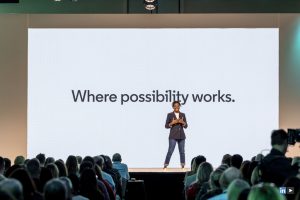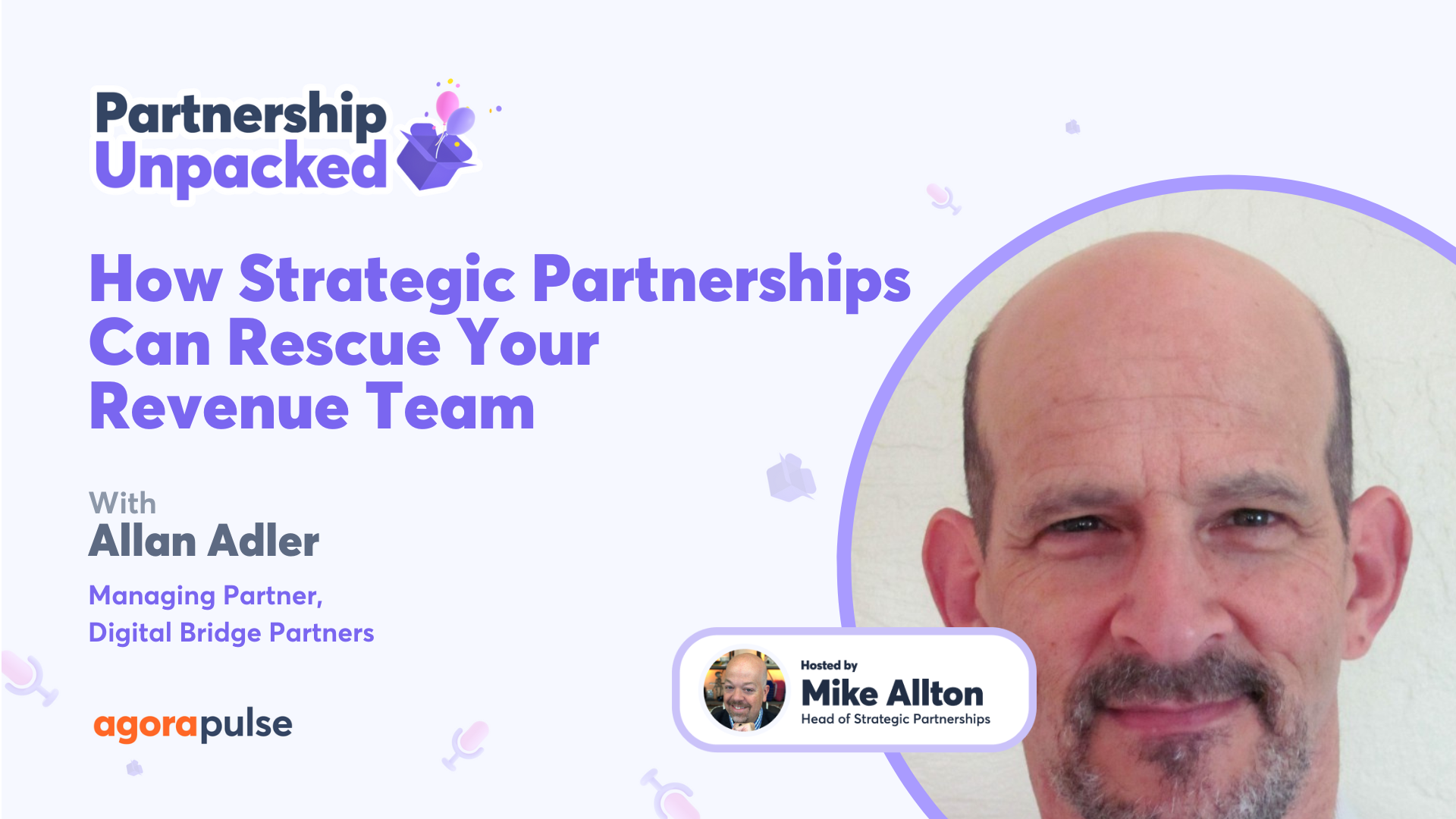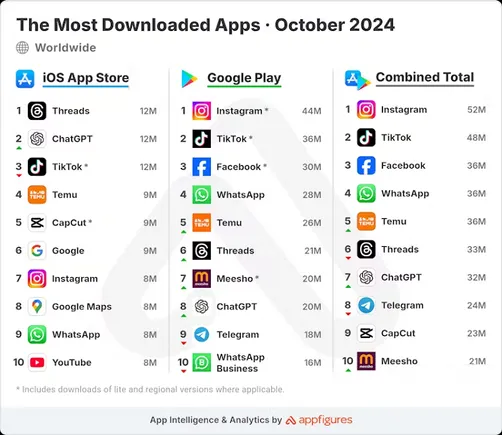How is your revenue team doing?
Did they miss their numbers last period? Are they frustrated with a lack of qualified leads and pipeline?
Are they looking to partnerships, and to YOU, for help?
That’s what we’re covering in today’s episode of Partnership Unpacked.
Welcome back to Partnership Unpacked, where I selfishly use this time to pick the brains of experts at strategic partnerships, channel programs, affiliates, influencer marketing, and relationship building… oh, and you get to learn too! Subscribe to learn how you can amplify your growth strategy – with a solid takeaway every episode from partnership experts in the industry.
Now I don’t know about you, but so many of the sales and revenue team members I talk to these days are hurting.
They’re struggling to get leads.
They’re struggling to close deals.
And guess what… they’re looking to us as partnership leaders to help! Whether that’s partnering with brands to bring in new marketing leads, or creating stronger channel partners who can resell or refer.
But what if you could bring partners to the table who could not only drive pipeline, but also increase those close rates and even drive up deal size?
Would that be beneficial to you and your revenue team?
That’s exactly what Allan Adler is going to talk to us about.
Allan is known worldwide as a Chief Ecosystem Officer and helps clients build partner ecosystems and accelerate their ecosystem flywheel. (I love that metaphor) He is the creator of the GoToEco framework that helps unlock the potential of Ecosystem and transform businesses for good by leveraging co-selling orchestration to achieve co-selling mastery. As the Chair of the Ecosystem Counsel at PartnerHacker and an Executive Member of Partnership Leaders, he’s immersed in the partnership world and the perfect guest to help us, and our revenue teams, today!
Partnership Unpacked host Mike Allton talked Allan Adler about:
♉️ How co-selling with partners works
♉️ What partner co-selling success looks like
♉️ How to find the right partners for co-selling
Subscribe to the show calendar: agorapulse.com/calendar
Learn more about Allan Adler
Resources & Brands mentioned in this episode
Full Notes & Transcript:
(Lightly edited)
How Strategic Partnerships Can Rescue Your Revenue Team with Allan Adler
[00:00:00] Mike Allton: How is your revenue team doing? Did they miss their numbers last period? Are they frustrated with a lack of qualified leads and pipeline? Are they looking to partnerships into you for help? That’s what we’re covering in today’s episode of Partnership Unpacked.
This
is Partnership Unpacked, your go to guide to growing your business. Through partnerships quickly. I’m your host, Mike Alton, and each episode unpacks the winning strategies and latest trends from influencer marketing to brand partnerships and ideas that you can apply to your own business to grow exponentially.
And now. The rest of today’s episode,
welcome back to partnership unpacked, where I selfishly use this time to pick the brains of experts at strategic partnerships, channel programs, affiliates, influencer marketing, and relationship building. Oh, and you get to learn to subscribe to learn how you can amplify your growth strategy with a solid takeaway every episode from partnership experts in the industry.
Now, I don’t know about you, but so many of the sales and revenue team members I talk to these days are hurting. They’re struggling to get leads. They’re struggling to close deals and guess what? They’re looking to us as partnership leaders to help, whether that’s partnering with brands to bring in new marketing leads or creating stronger channel partners who can resell or refer.
But what if you could bring partners to the table who could not only drive pipeline, but also increase those close rates and even drive up deal size? Would that be beneficial to you and your revenue team? Well, that’s exactly what Alan Adler is going to talk to us about. Alan is known worldwide as a chief ecosystem officer and helps clients build partner ecosystems and accelerate their ecosystem flywheel.
I love that metaphor. He’s the creator of the GoToEcho framework that helps unlock the potential of ecosystem and transform businesses for good by leveraging co selling orchestration to achieve co selling mastery. As the chair of the ecosystem council, a partner hacker, and an executive member of partnership leaders, he’s immersed in the partnership world and the perfect guest to help us and our revenue teams today.
Hey, Alan, welcome to the show.
[00:02:14] Allan Adler: Hey, thanks, Mike. Great to be here. [00:02:16] Mike Allton: My pleasure. Now, could you start by just sharing how you got into partnerships and more about how you’re helping businesses today with digital bridge partners? And I’d love to hear your perspective on how the industry is changing, particularly this year. [00:02:31] Allan Adler: Yeah, so I’ve been blessed to be in the partnership business for more than three decades, and one might ask, like, what the heck are you doing hanging around this long? And the answer to that question is because of how much has changed. I grew up essentially as a channel expert. I ran the largest channel consultancy at the turn of the millennia and saw the evolution of indirect channels going from you.
Something that wasn’t a big deal to a pretty big deal and then started to see some real interesting things started to happen around the later part of the arts when you saw the growth in cloud computing you saw the growth in infrastructure service in the you know behemoths of google and salesforce.
Microsoft, of course, establishing a whole new sort of trajectory on technology with cloud computing and infrastructure services. And that’s when partnerships really changed. They began an extra shift away from indirect, very sweet, dominated, go to markets to these best of breed sass applications, which fundamentally, you know, Change the nature of how we have to partner and go to market.
And that’s when I got really excited about the whole ecosystem concept and the idea of moving from monodirectional partnerships, which channels were one direction to two way partnerships, where you’ve got the whole gambit of co X, co innovation, co marketing, co selling, which we specialize on heavily today in co retention.
So that’s just a little tour of last 30 years. And particularly the last four or five years when pretty much everything’s changed.
[00:03:56] Mike Allton: I love it. And like I was telling you before we even started to record, I’m relatively new. I feel like to the partnerships business, but I actually come from the background.
So I was part of Intel and IBM’s channel partner program. And to your point, it was very one way, but there was no relationship there, right? The folks at Intel or IBM. Didn’t know who my little it firm in northern ohio was and frankly, they could have care less. We bought all of our stuff from cynics and the other vendors and the resellers.
And that was it. But that was partnerships back then. And today, like you said, there’s just so much more technology that’s enabling true partnerships, collaborative work and co selling, which, of course, we’re gonna really dig into.
[00:04:37] Allan Adler: Yeah, it’s interesting because many people who have tried to make the transition from what I call sort of the channel world of the ecosystem world of struggle.
Because they’ve tried to apply the same principles to working in a Co X environment. The last time I checked, a channel only went one direction. And if you think about the origins of channel, it was very much a function of needing to move an object from one part to another part. You know, you put it on the boat one place, and then the channel takes the boat to the next place, you unload it and deliver it.
Well, last time I checked, Software didn’t need to be shrink wrapped and so you don’t really need to ship anything anywhere. And more importantly, pretty much all the value is happening around the product and around the entirety of the customer experience and not just in the delivery of it to. From a point of sale perspective or logistics perspective so that shift from point of sale and proximity to folks around sound the customer to the entirety of the process very importantly being digital changes everything because now we’re talking about innovation at the product level that’s probably the biggest shift if you will and partnering now versus before is it starts at the product.
Doesn’t start at the go-to-market and if you don’t get the product piece right, the go-to-market gets at least significantly subverted, if not completely made irrelevant or ineffective.
[00:06:07] Mike Allton: Absolutely. Absolutely. Right now at Catalyst this year, which by the way, I wasn’t able to attend this year. I can’t wait to go next year.
I’m already thinking about it. There was so much FOMO going on. You guys had such a great time, it looked like, and, and so much relationship building, but a catalyst this year, that’s the partnerships industry event, right? That’s put on by partnership leaders. You offered a terrific presentation alongside Rob Rebholz and Derek Safko entitled How a Co Sell Program Can Rescue Your Revenue Team.
That’s what I want to dive into today. So my first question is going to kind of help set the stage for everyone listening. What’s the problem or the challenge with sales and revenue teams today?
[00:06:44] Allan Adler: Yeah, well, I think you kind of said it in your intro. No one’s making quota. Whether it’s BDRs who have a 3 percent conversion rate or AEs who book meetings and then really struggle to drive close one.
There’s just a paucity of unfulfilled quota objectives out there, principally as a function of the fact that inbound and outbound motions, which have been kind of de rigueur for like go to market, have basically matured to the point of being like copied by everybody and no longer really work. Or if they work, they’re predictably bad.
It’s really funny because the whole start of the whole BDR, SDR motion was a book called Predictable Revenue where formulaic models were built for teaching revenue leaders how to go about making quota of farting at the top of the funnel with the BDR who takes some prospect and turns it into opportunity and then an AE who takes the opportunity to close one hole.
All that’s based on inbound and outbound motions that essentially have run their course. Everyone’s copied each other. And there’s a giant plethora of wasted resources just in BDR spend alone. If you take the combination of salaries and lead management, outbound demand generations, 20 billion to spend on SAS with a 3 percent conversion rate.
So anybody who’s gotten a little calculator out, it’s going, wow, we’re losing 11 billion plus some wasted on trying to annoy customers. And I think the most important reason it’s not working is because 80 percent of customers want to start their buying journey with an ecosystem. Person a trust and so when we go direct we’re actually indirect because the customer wants to go direct to a trusted provider so we’re not working with the trusted provider of our customers were essentially.
Bypassing 80 percent of the way the customers wanna buy and that’s pretty much in a nutshell why we have to turn to co selling. There are some other reasons like indirect and channel doesn’t really scale very well in sass. We can go into that if you’re interested, but co selling is really the only answer.
And then the question is, how do we turn co selling into predictably good revenue? Now that the former predictable revenue models of inbound and outbound are predictably bad.
[00:08:51] Mike Allton: Yeah. And you said it, that’s the sound bite. We’re spending 11 billion to annoy customers. So of course it’s not working. Because we’re not the only ones, right?
To your point, this is the outbound, inbound motions. Everybody knows how to do them now. In fact, AI is taking over and doing it for us predictably badly. So you teed it up perfectly. How exactly does co selling with partners
[00:09:16] Allan Adler: I think the first thing you have to do is to unpack what is co selling because co selling is not a one size fits all.
There are various different ways to segment and differentiate aspects of co selling that a revenue leader really needs to land on first and foremost. There’s four distinct segments of co selling. One of them is the reciprocal programmatic approach that we’re talked about at Catalyst, where you’ve got partnerships with like kind companies, typically ISVs and agencies that are in some sort of reciprocal map with you.
In other words, you kind of, it’s not David and Goliath, it’s more like two peers. But you also have other kinds of co selling where you do have the David and Goliath, that’s like more of the hyperscalers. Like, you’ll see co selling conversations happen, AWS, GCP. Microsoft azure co selling that’s not a reciprocal co selling that’s really a david and goliath is like really big companies if you want to play with them you play against their rules just those two out of the four there are other co selling models really are quite distinct so when you say hey we need co selling you really need to step back and say which part of co selling is going to get us where we need to get to and then invoke the right Thank you.
Repeatable and predictable revenue models associated with that particular segment, because you can’t make the application of one set of process people and technologies apply unless you’ve got it tuned to the right objective. So that’s just a starting point is not all co sellings alike before you start co selling start to think what problem my solving and which partners are my solving it with.
I say that again, what problem am I solving and which partners am I solving it with? And once you know the answer to those questions, then you can say, ah, let’s use this co selling methodology and this set of processes, these set of people and these sets of technologies to get the job done. So hopefully that answered your high level question, but bringing it down to what CoSelling was at Catalyst and what we were talking about, we were speaking to this very important segment in CoSelling called Reciprocal CoSelling, where you’re a software company, and let’s just take technology partnerships as an example, and you’ve got a group of technology partners that you’ve Bye bye.
Successfully developed integrations with you got a really good reciprocal list of opportunities on both sides you have opportunities that are in their customer base they have opportunities in your customer base and you want to kind of develop this repeatable motion. In order to be able to go to your CRO and say, if we work with this set of partners in this way, we can three to six X, the current partner business, if we follow these prescribed processes and build these kinds of reciprocal relationships, and we can obviously drill into that some more.
[00:11:57] Mike Allton: Yeah, and I love that you mentioned David and Goliath because we had Sam Yarbrough on the show just in the previous episode. Talking about her relationship at PFL with Salesforce, which is a great analogy for David and Goliath. So for those who want to dig into that kind of partnership, go back and listen to that episode.
But today we’re definitely talking about what you’re bringing up in the second instance is that more reciprocal relationship where you as the brand are partnering with other brands. Who are probably somewhat similar in size, at least there’s not a huge difference in their size. Like, you know, Agorapulse for a SaaS company.
We’re targeting, you know, mid market large enterprise companies. So we’re partnering or I’m developing partnerships, right? With other brands who are targeting that same audience. And they’re about the same scope as we are. Yep.
[00:12:44] Allan Adler: So the first thing you need to do to get this right is think about the two questions I set up first.
What are my objectives? That is to say, which customer segments do I want to drive revenue with? And which revenue objectives do I want to achieve within those customer segments? So let’s just unpack that for a second. So let’s say you say, where I’m really struggling with my revenue team is in the mid market in the U.
S. with product X. And what I’m really struggling with, no surprise, is getting new logos. Everybody’s struggling with new logos. And so then I asked the question, which partners do I have a reciprocal relationship with that could help me? And where can I explore a total available market as a function of account mapping with those partners to say, aha, five partners could help us if we got 10 percent of the overlaps, make our numbers for the next 18 months.
So now we’ve got the segment, the revenue objective and the partners, and now we have zoomed in on our scope of influence. And we can apply the methodology we’ve created to three, the six X, the revenue with those partners in that segment against those revenue objectives. You’ve got to be meticulous like that, because if you don’t do it that way, you end up with what I call random acts of partnering and guess what that isn’t.
Predictable revenue. And the only thing a chief revenue officer is going to give partner people money for is if we can show predictable revenue and step by step by step, don’t try 25 partners and 16 revenue segments and 12 different revenue objectives, zoom in, get it right, rinse and repeat, grow it.
That’s the ticket.
[00:14:19] Mike Allton: Love it. Love it. And in fact, we had Jared Fuller on the show earlier. And again, you know, for those of you listening, I’ll link to those past episodes. We talked a lot about using reveal and discovering that those mapping and figuring out what those overlaps are. But in your talk, you mentioned that partner deals like the ones we’re talking about, they close 50 percent faster.
And are typically twice as large in terms of ACV and why is that and how exactly can co selling with partners rescue that revenue team?
[00:14:48] Allan Adler: Yeah, so let’s just bring this to the revenue metrics that matter, right? At the end of the day, there’s two things that a co selling machine can do for you. It can get you sourced revenue, get you influence revenue.
Now, whereas influence revenue is really cool. And typically undervalued, it really isn’t the place to start right now, because your chief revenue officer is really going to ask you to, you know, show me the money, which basically means bring in the new leads. So let’s start with the single most important thing that a co cell machine can do for us in this reciprocal model.
And that is to get introductions. From our partners who have a customer that overlaps with our prospect, and we have created something called the partner assist motion, which is basically a standardized process that goes from partners ready to work with us to triggered overlap suggests an opportunity to a set of ask for and get assistance that then is shown to have four times the conversion rate of BDR activity.
Remember back, we talked at the beginning about the 12 billion spent on BDRs and another 8 billion spent on lead generation is 20 3 percent close rate. That is bad, predictable revenue. So we found that we can 4x. That conversion rate with an introduction from a partner back to the data point, I said, 80 percent of all customers want to start their buying journey with someone they trust.
Well, guess what? An intro from a partner who’s a customer that’s associated with their prospect is it is an intro from a partner. Their customer trusts. That’s why you get 4X. So if we just start there and say, simple story, Thank you. Take half the money that you’re spending on BDRs and give it to me to drive co selling and I will double the production of the BDR and you can take the other half of the money and do whatever you want or give it to me and I’ll quadruple it but the net of it is if I can 4x the conversion rate, I have a predictable revenue model and that’s oversimplifying the overall motion but at least puts into perspective just how cool Partner system, coastal motions can be, if you can standardize on a reciprocal partner relationship and institute that across your company.
[00:16:59] Mike Allton: Love it. Love it. That’s exactly what I’m working on implementing right now at Agorapulse. So folks, we’re talking to Alan Adler about how to drive more revenue with your partnership activities and here to talk to us about how to drive more revenue with social media is our CMO at Agorapulse, Daryl Prail.
It’s the Arc de Triomphe. Can you imagine if you’re in charge, if you’re the CMO of Marketing Paris, what are your main channels? The Arc de Triomphe, there’s the Eiffel Tower, there’s the Louvre. Those are your channels you’re going to use to drive tourism dollars in. Okay now, but you’re not the CMO of Paris.
In fact, you’re the CMO of your company, product, service. So what are your main channels? So I’m going to guess they’re things like pay per click, maybe trade shows events. Maybe content. Those are all pretty predictable, right? Let me ask you this question. Are you treating social media as a main channel? By the way, only 1.
8 percent of you today measure social media and can prove an ROI in that investment. HubSpot and Gartner say social media is the number one channel to invest in this year. Are you doing it? If not, I can tell you why. You’re not doing it because you don’t have the tools, you don’t have the mentality. And that’s okay.
We’ve got you covered. You change the mentality. We’ll give you the tour of GorePulse tracks all the ROI for you. One place to manage all your social media activity. Your number one channel. Change your success. Treat social media as channel. One CMO to another. My name is Daryl. I’m with the GorePulse. I’ll talk to you soon.
Oh, this is fantastic. In your talk, you mentioned about how breakthrough success depends on three co sell pillars, and you listed them as align on co selling, orchestrate with partners, and standardize process. Can you walk us through those?
[00:18:51] Allan Adler: Sure. So aligning on co selling is the most important because Until and unless we’re clear on, like, what market segments we’re going to go after, what revenue activities we’re going to drive, like mid market, that’s the segment, revenue activities, net new leads, net new logos.
We can’t really then go to a partner with whom we would orchestrate standardized motions, those other two things, because we’re not ready to give. So the story goes like this, set up a business case with your CRO to show them that you can 3 6x the partner business by following a proven predictable revenue program.
We’ll call that CoSell program for now, right? And that means we sit with our CRO and we say, if we do these things, we’ll get these things. So why that alignment is so important is because before we go to standardizing our motions and orchestrating our partners, we have to be prepared to give if we want to get.
So the one thing that makes reciprocal co cell relationships so interesting is unlike in other relationships, we’re not paying the partner. We’re not paying for leads. It’s not some affiliate program where they get 50 bucks or a Starbucks coupon. If they prefer the business, this is a reciprocal relationship.
I give you leads, you give me leads. I give you influence, you give me influence. And so like the case of Reveal and you had Jared on, which was just fantastic. We worked together closely on the process of getting intelligence, getting an introduction and getting influence. But guess what happens when you go to the.
Partner and you say, hey, give me all these things. I said, well, what are you giving me? So that first step aligning with the revenue teams is a creative business case, such that you can go to those partners with whom you want to orchestrate with those standardized processes with a promise that we’re going to give.
So what it means is I take those five or six partners that are really important. And I have a partner manager say I’m the partner manager. I sit down with their partner manager. I say my CRO. Is prepared to give your reps introductions influence on deals that are your prospects and opportunities that are in my customer base in exchange for that.
We’d like you to work with us in some form of a S. L. A. Where we offer each other some confidence and accountability that when I ask for an assist, you’ll get back to me with a yes, I’ll provide it. And once you say yes, that you’ll complete that assistant, there’ll be an email to the customer, copy my rep that says, love to introduce you to Bob, who is at one of my trusted partners, where we have this better together story, blah, blah, blah, and that all of that is agreed to.
So, that’s alignment. Let’s get really clear with our reps. Now, the next phase is basically standardize the motion, which is the back end of the alignment process. So, working with RevOps to say, what exactly are we going to do step by step by step from the SLA to the triggered overlap, to the request, to the confirmation of the request, to the getting of the assist, to driving that to closed one.
Very structured process so that when I sit down with my partner, not only do I have an SLA, but I tell them exactly what I’m going to do, how I’m going to do it, when I’m going to do it. And I asked them if they would do the same because of course for a TV reciprocal, they’re going to need to process too.
That’s one of the challenges in any of this stuff is reciprocity requires that both people are asking and getting in some kind of cadence fashion so that you don’t end up with, you know, a bunch of mismatched relationships, which, as we know, reciprocal relationships have a cadence of a fairly consistent giving and getting, and they grow together with that understanding of giving and getting and not a disproportionate one giving and the other disproportionate getting.
So, hopefully, that explains alignment. Standardization and orchestration in that order.
[00:22:40] Mike Allton: Love it. I love that you talked about the reciprocity because that was the exact question that my VP of sales asked me when I presented to him. This is the program that I’m putting together. It’s like, why would they do that?
What’s the incentive? What are we paying them? And I’m like, no, no, no, no, there’s no incentive. Tell your point. There’s no Starbucks card. It’s mutual goodwill. It’s helping each other grow together. And maybe that was a little boo boo for him. So I will play this back for him and let him understand from your words, how this is reciprocating each other.
[00:23:07] Allan Adler: Goodwill is really important and good feelings are important, but they have to be matched with results. So I’m a big believer in the idea that partnerships can truly provide business with a whole new platform for transforming business to do good. It is no doubt about the fact that we have to get, as Jared says, the W’s on the board in order to get the credibility that we’re solving for a problem.
And if we apply the good human behavior of treating people fairly, kindly, respectfully and reciprocally. And we perform, we transform business because that’s what good business is. Produce the results and do it with heartfulness, presence, and a sense of goodwill, goodwill and money together.
[00:23:57] Mike Allton: Love it. So as I mentioned, this is the program that I’m, that I’m initiating at Agorapulse and I want to prove that it works for those of you listening, maybe just on the same journey as me.
You want to make sure that you’re proving to your boss, whether the CRO or somebody else. Got to achieve some early wins, right? You kind of intimated to that earlier on. How would you get started?
[00:24:17] Allan Adler: Yeah, I think the 1st and most important thing to do is to do an assessment of which segments, which revenue motions and which partners are going to deliver on the.
Um, we’ll call sort of like the accelerated predictable revenue pilot you’re going to run. So depending upon the level of maturity that you have with both your operations and your partner relationships will determine how quickly you can go. So there are a few prerequisites that you have to get ready to do before you start putting together a business case.
You need to do account mapping. So whether it’s with reveal or cross beam, you need to basically have an account mapping infrastructure in place and you need to use that. To show the business opportunity with that small number of partners that you’re going to work with. So that’s one prerequisite. The second prerequisite is that you should already have a group of partners where you have the following characteristics, a lot of mutual overlaps.
That is you have opportunities and prospects in their customer base and vice versa, where you have a high ICP overlap, which means that they’re selling to the same buyer that you are, or if they’re not, they’re close. You don’t want someone selling to a buyer. Five doors away you want them selling to the buyer in their office or right next to their office.
Third thing is you really must have a strong partner manager to partner manager relationship. So don’t put a partner up for nomination for this program where they don’t even know who you are anymore because you’re not talking to them or they have no partner manager because they got fired. Pick a partner where you partner manager and their partner manager have a close relationship.
If you have those prerequisites, you’re ready to apply for a business case. What I mean by that is. We have a standardized formula where we can actually walk through and produce the business case that will show a 3X to 6X increase in the partner sourced influence business with that set of partners in 6 to 12 months if you follow the process right.
So once you have the business case in place, then you’re basically talking to your CRO saying, can we try this with X number of partners? We recommend if you’re in the very early stages that you try it with like three. If you’re a little more mature, you can take it up to ten, but you don’t want to get ahead of yourselves because you really have to get the process in place and working before you start to press the accelerator.
It’s also important that you pick you either have someone in operations or you have a partner you can work with my firm does this. There are others that do it. Well, who could be brought in to help you guide the development of your program all the way from the creation of the business case through the operations and orchestration.
And so this is where it’s really key critical to, like, have the operations team. Be prepared to accept the standardized playbook or the standardized coastal motions that I mentioned and have that prescribed approach be the one you use so that metrics are clear. CRM tracking is clear. We know how to ensure that we can report on the results.
And that essentially is the. Prerequisites to success. Many people skip the co sell business case step that’s a mistake because what happens is then you don’t get the CROs commitment and the CCOs commitment. Cause oftentimes it’s the chief customer officer, CCO, who’s the one that has the customer success team, that’s going to be doing the giving to the partner.
So. If your CRO covers your CCO great, otherwise, you’ve got to get your CRO and your CCO online to say we need to do some giving here. If we do some giving, we can three or six access business. Let’s go do the giving. Let’s get ready to do it. And we can talk more about what that entails. It’s not complicated.
At the partner assist level, because it’s really just an intro or just an influence, which is typically getting someone who knows the customer to send an email, believe it or not, all by itself, particularly in intros that can forex the business. So, when you have something so simple as get the partner to make an introduction against a prospect that is on the radar of your CRO.
Oh, this is pretty simple. Of course, the mechanics are a little bit complicated, but. This is practical, pragmatic, doable, and proven. You just have to have the courage to stand up and say, We need to invest. We need to give. Let’s make it happen.
[00:28:35] Mike Allton: So cool. And I loved your advice about limiting the number of partners that you’re trying to ramp up.
At first. This is something that quite frankly, I was a mistake that I was on the verge of making. So thank you. Because that’s very timely. I started using reveal. In late November of 2022, so almost a year ago because I had been at a conference and one of their wonderful beers came up to me at the event and started talking to me about reveal.
And I had a couple of partners through co marketing motions asked me to connect with them and reveal. And at the time I didn’t get it. I didn’t understand because I was really immersed in co marketing and influencer marketing. So she explained to me how overlaps work and why that be beneficial to me.
And so cool. I signed up for an account and I connected some more partners and didn’t do anything with it for months, really. So it’s just been in recent months that we’re starting to ramp up. We’re now invested. We’re full steam ahead. And yeah, one of my thought processes at the time was, Oh, I need to bring in more partners and more partners.
And so thank you for that advice.
[00:29:35] Allan Adler: Yeah. Yeah. The other thing is really important to do is to understand that there are really two types of partners. Oversimplifying technology partners and services partners. So a services partner system integrator agency consultant value added reseller there’s lots of terms managed service providers those partners typically have slightly less orientation around account mapping the technology partners do where there’s this true.
Motion and so what we believe is that in your overall program you need to cover both. But the motions and the order might be different based on where your maturity lies, like some of our clients are weaker on their tech program, but stronger in the consulting program, some of our partners the other way around.
So you kind of have to client, some of the, you have to decide, like, where do you have the highest probability of being able to produce a predictable revenue model with the smallest number of partners in the shortest amount of time, full stop, rewind and listen to that. That’s what you have to do, right?
Because one of the things you discover when you go to places like catalyst is you get all these people who are really excited about partnering. They have no budget. Literally party people. No budget. Zero. Why do they have no budget? Only one reason because they’ve not become operators who have produced a predictable revenue model.
That’s it. So everything you should be doing should be around. I must be able to in the next 6 to 12 months prove a repeatable predictable revenue model or else. Not a good story happens. We already know what the not a good story has been for the last 18 months. Lots of riffing. You don’t fire people that have predictable revenue models, especially when you’re not making quota anywhere.
So this is why we use the term rescue. We literally are the boat that can rescue all of the reps swimming in the water, put them on a boat and bring them to the promise land. Partners can do this if we are disciplined and follow procedure that’s been proven to work. And it’s like, it’s exciting because we now have the, we’ve just.
Just turn the corner with the right process and the right tools. I’m thinking about tools like Super Glue, like Reveal, like Crossbeam, like Lean Data, that are now, when paired with the right process, can produce predictability. And then the people part, which is us, is getting alignment, which is always hard, never going to happen if you don’t have those other two things, the process and the technology ready to roll.
And that’s, that’s why I’m super excited because I think we’re at that turning point. Where we can really be a ship that doesn’t have a bunch of holes in it and therefore can bring people on the boat.
[00:32:11] Mike Allton: I’m excited too. And this is a great way to wrap up the show. Folks, I’ll have links to a reveal super glue and all the other tools that Alan just mentioned.
In fact, also have a link to the interview I did with Rob from super glue a few weeks ago. Alan, I just have one more question for you, and this is the same question I ask every single one of my guests, because I love hearing how they answer it. How important have relationships been to your career?
[00:32:37] Allan Adler: I would say my career has been relationships.
I would say that a career without relationships is not a career, because at the end of the day, you know, relationships are the foundation of everything. Everything’s about relationships. It’s only when we’re lost in the water that we think it’s all about me. The thing that’s really proven time and time again, to me is that when I treat my relationships as my most important asset, then everything else works its way.
You know, when I take care of my partner relationships and serve their needs, they’re incentivized and motivated to serve mine. So rather than taking the attitude of like, what do you got for me, which is a very take orientation, I think the attitude of helping with the understanding that if I help and build relationships that are potent and powerful.
Not only will I have lifetime friends, but I’ll have the success and I will have the legacy to say, if you want to know there’s an old parable and spiritual and religious tenants that says judge a person by their fruits. And what it basically means is if you want to find out how successful someone has been and how important they’ve been.
Look at their relationships and they’ll point back to the kind of energy and the kind of commitment that comes from caring and comes from helping. And those are all the people that I want to be with and the ones who, who have helped me and I hope I’ve done a, an adequate job of helping them.
[00:34:05] Mike Allton: A career without relationships isn’t a career.
I love it. Fantastic. Alan. This has been amazing. For those of us listening, like myself, who could really use more of your help and have your professional guidance, can you let them know where they can find you, learn more about you?
[00:34:20] Allan Adler: Yeah, for sure. I would say DM me on LinkedIn. I’m always on LinkedIn, always talking about this stuff, and I’d be happy to chat with anybody who needs the support.
We’re all there for you.
[00:34:31] Mike Allton: Fantastic. And folks, that’s all we’ve got for today. Please be sure to like us and subscribe on Apple. We have a ton more fantastic episodes, just like this one coming at you, where I continue to dive into and share with you my journey along implementing Nearbound at GrowPulse.
Until next time. Thank you for listening to another episode of Partnership Unpacked. Hosted by Mike Alton and powered by Agorapulse, the number one rated social media management solution, which you can learn more about at agorapulse. com. If you enjoyed this episode, please subscribe on your favorite podcast player.
Be sure to leave us a review. Your feedback
is important to us. And if you
want to be part of our audience during live broadcasts, take a look at our calendar at agorapulse. com forward slash calendar.











